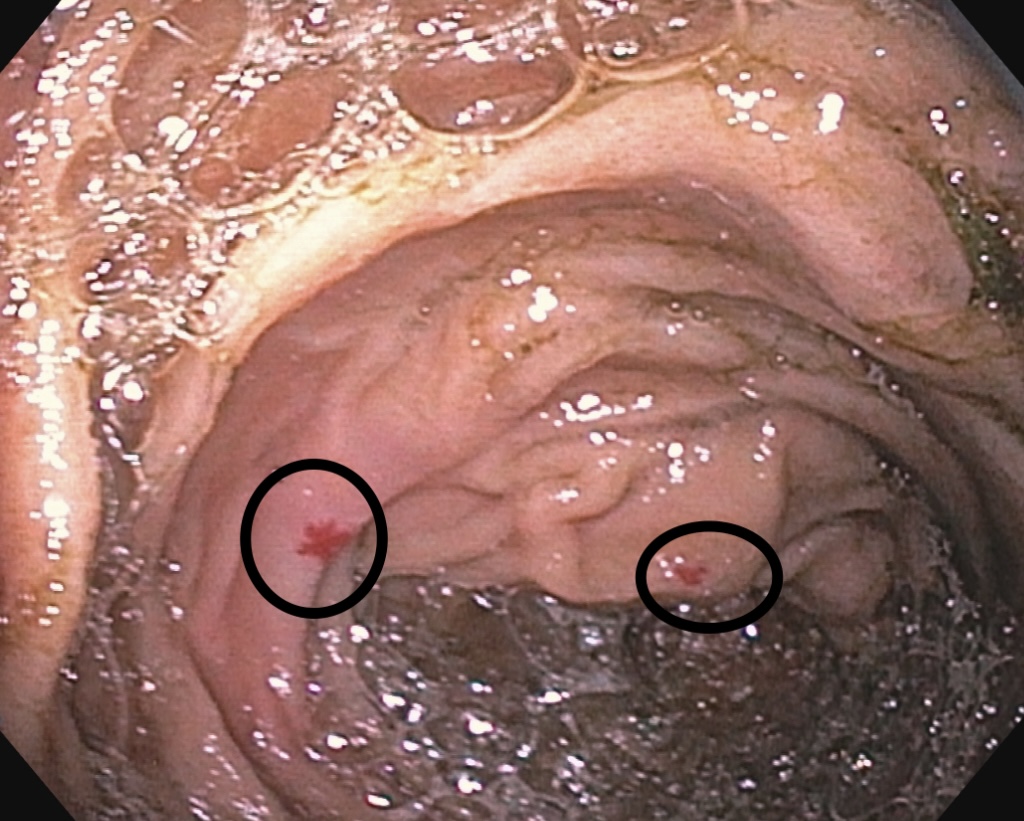Tuesday Poster Session
Category: GI Bleeding
P5251 - Hunting for Heyde: The Role of the GI in the Treatment of Aortic Stenosis Associated Arteriovenous Malformations
Tuesday, October 28, 2025
10:30 AM - 4:00 PM PDT
Location: Exhibit Hall

Noah Weinstein (he/him/his)
Wake Forest University School of Medicine
Winston-Salem, NC
Presenting Author(s)
Noah Weinstein, 1, Pembroke Nash, MD2
1Wake Forest University School of Medicine, Winston-Salem, NC; 2Atrium Health Wake Forest Baptist, Winston-Salem, NC
Introduction: Arteriovenous malformations (AVM) are a common cause of bleeding in the GI tract and have long been associated with the presence of aortic stenosis (AS) in what is commonly known as Heyde syndrome. This association represents a unique intersection between the fields of Gastroenterology and Cardiology. In this vignette we discuss a case of recurrent AVMs in a patient with severe AS, and the role of the gastroenterologist in helping the patient find a more permanent treatment.
Case Description/
Methods: A 76-year-old male with a past medical history significant for severe AS, recurrent AVM of the GI tract treated with argon plasma cautery (APC), heart failure with recovered ejection fraction, atrial fibrillation previously on apixaban, chronic anemia, and COPD presented from his primary care clinic with concern for melena and fatigue. Initial workup was significant for worsened chronic anemia, and the patient was admitted for inpatient evaluation by gastroenterology as well as red blood cell transfusions. Upper endoscopy at this time revealed several (15 – 20) AVMs throughout jejunum with active bleeding. APC was used to achieve hemostasis at all but one site, which required the placement of a ligating clip. Lower endoscopy noted small internal hemorrhoids and melena, but was unable to be completed due to inadequate prep. Following the intervention by gastroenterology, the patient was able to maintain his hemoglobin goal of greater than 7 and was discharged. While the patient refused discussion of surgical repair of his severe aortic stenosis, when informed of the option, he was amenable to transcatheter aortic valve replacement and was deemed an appropriate outpatient candidate, with plans to undergo TAVR in the coming months.
Discussion: Heyde syndrome is a multi-organ disorder characterized by AS, GI bleeding and acquired Von-Willibrand factor deficiency. With treatment of the AS, bleeding can totally resolve. In this case, the patient had a longstanding history of AS, but had repeatedly declined surgical repair years prior, eventually becoming lost to cardiology follow up. Unfortunately, as the patient’s AS progressed, recurrent GI bleeds led to repeated hospitalizations with increasing transfusion requirements. Ultimately, Heyde syndrome is a cardiac pathology with gastrointestinal consequences; as such, there is a significant role for the treating gastroenterologist to play in helping the patient understand, broadly, what more permanent treatment of their AVMs may entail.

Figure: AVMs found on upper endoscopy.
Disclosures:
Noah Weinstein indicated no relevant financial relationships.
Pembroke Nash indicated no relevant financial relationships.
Noah Weinstein, 1, Pembroke Nash, MD2. P5251 - Hunting for Heyde: The Role of the GI in the Treatment of Aortic Stenosis Associated Arteriovenous Malformations, ACG 2025 Annual Scientific Meeting Abstracts. Phoenix, AZ: American College of Gastroenterology.
1Wake Forest University School of Medicine, Winston-Salem, NC; 2Atrium Health Wake Forest Baptist, Winston-Salem, NC
Introduction: Arteriovenous malformations (AVM) are a common cause of bleeding in the GI tract and have long been associated with the presence of aortic stenosis (AS) in what is commonly known as Heyde syndrome. This association represents a unique intersection between the fields of Gastroenterology and Cardiology. In this vignette we discuss a case of recurrent AVMs in a patient with severe AS, and the role of the gastroenterologist in helping the patient find a more permanent treatment.
Case Description/
Methods: A 76-year-old male with a past medical history significant for severe AS, recurrent AVM of the GI tract treated with argon plasma cautery (APC), heart failure with recovered ejection fraction, atrial fibrillation previously on apixaban, chronic anemia, and COPD presented from his primary care clinic with concern for melena and fatigue. Initial workup was significant for worsened chronic anemia, and the patient was admitted for inpatient evaluation by gastroenterology as well as red blood cell transfusions. Upper endoscopy at this time revealed several (15 – 20) AVMs throughout jejunum with active bleeding. APC was used to achieve hemostasis at all but one site, which required the placement of a ligating clip. Lower endoscopy noted small internal hemorrhoids and melena, but was unable to be completed due to inadequate prep. Following the intervention by gastroenterology, the patient was able to maintain his hemoglobin goal of greater than 7 and was discharged. While the patient refused discussion of surgical repair of his severe aortic stenosis, when informed of the option, he was amenable to transcatheter aortic valve replacement and was deemed an appropriate outpatient candidate, with plans to undergo TAVR in the coming months.
Discussion: Heyde syndrome is a multi-organ disorder characterized by AS, GI bleeding and acquired Von-Willibrand factor deficiency. With treatment of the AS, bleeding can totally resolve. In this case, the patient had a longstanding history of AS, but had repeatedly declined surgical repair years prior, eventually becoming lost to cardiology follow up. Unfortunately, as the patient’s AS progressed, recurrent GI bleeds led to repeated hospitalizations with increasing transfusion requirements. Ultimately, Heyde syndrome is a cardiac pathology with gastrointestinal consequences; as such, there is a significant role for the treating gastroenterologist to play in helping the patient understand, broadly, what more permanent treatment of their AVMs may entail.

Figure: AVMs found on upper endoscopy.
Disclosures:
Noah Weinstein indicated no relevant financial relationships.
Pembroke Nash indicated no relevant financial relationships.
Noah Weinstein, 1, Pembroke Nash, MD2. P5251 - Hunting for Heyde: The Role of the GI in the Treatment of Aortic Stenosis Associated Arteriovenous Malformations, ACG 2025 Annual Scientific Meeting Abstracts. Phoenix, AZ: American College of Gastroenterology.
